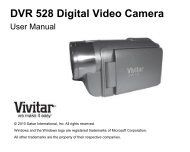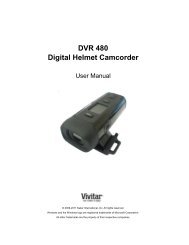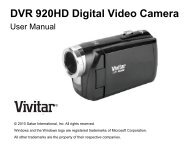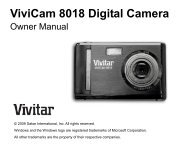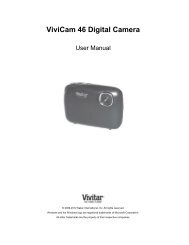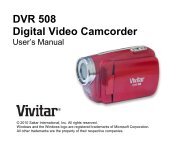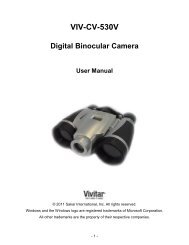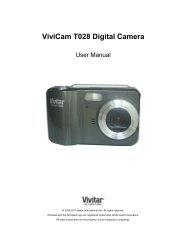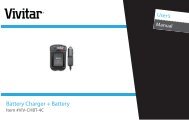INSTRUCTION MANUAL - Vivitar
INSTRUCTION MANUAL - Vivitar
INSTRUCTION MANUAL - Vivitar
- No tags were found...
You also want an ePaper? Increase the reach of your titles
YUMPU automatically turns print PDFs into web optimized ePapers that Google loves.
V-800MR800mm Mirror Lens<strong>INSTRUCTION</strong> <strong>MANUAL</strong>
Limited Five Year Warranty<strong>Vivitar</strong> warrants this quality product to be free of defects in material and workmanship for aperiod of five years from the date of purchase. During the period, <strong>Vivitar</strong> will repair or replace theproduct at no charge for parts or labor.TIME PERIOD OF THIS WARRANTYThe time period of this warranty starts from the date of the original purchase and expires on thefifth anniversary date of purchase.WHAT IS NOT COVERED BY THIS WARRANTYNo express or implied warranty is made for any defects in this product which result fromaccident, abuse, misuse, failure to operate the product in accordance with relevant instructions,neglect, immersion in or exposure to chemicals or liquids, extremes of climate, fungus, excessivewear and tear/cosmetic damage and defects resulting from other extraneous causes such asunauthorised disassembly, repair or modification.This warranty shall not extend to any incidental or consequential damages arising from thepurchase, use or inability to use this product even if <strong>Vivitar</strong> has been advised of such damages.The laws of some countries and some States thereof do not allow the limitation of incidental orconsequential damages, so the above limitation or exclusion may apply to you.-1-
WHAT TO DO WHEN SERVICE IS NEEDEDSTEP 1. Package the product and relevant accessories carefully, using ample padding materials and a sturdymailing container to prevent damage in transit.STEP 2. Include in package:a) Evidence of date and place of original purchase (for example, a copy of your sales receipt).b) Detailed description of your problem.c) When possible, a sample evidencing the problem.STEP 3. Return item (insured) to: (in the U.S.):(in the U.K.)<strong>Vivitar</strong>Sakar UKAttn: Technical Support 2D Siskin Parkway East195 Carter DriveCV3 4PE, UKEdison NJ 08817When service is complete, the product will be returned to you shipping prepaid. In the event the product isdeemed to be not faulty or the defect is a result in wear and tear, <strong>Vivitar</strong> may levy a handling charge for thefrom country and State to State thereof. For more information visit our website www.vivitar.comTECHNICAL SUPPORTsupport team members will answer your questions. For phone support in the US please call 1-800-592-9541, in theUK call 0800 917 4831. If you would like to call from anywhere else, please visit www.vivitar.com for your local tollfree number.-2-
231500mm Mirror Lens1234Focus RingDistance ScaleIndex for DistanceMacro Ratio4-3-
SpecificationsFilter SizeMinimum Focus DistanceFocus ControlAngle of ViewGroups/ElementsLengthMaximum DiameterWeight: 30.5mm (rear mount): 5.7 feet (1.73 m): Single focus lens: 3 Degrees: 8/8: 5.7" (144.5 mm): 4.4" (111 mm): 1.94 lb (880 g)-4-
Your new Catadioptric or Reflex mirror lens is a highly developed, computer designed product which usesthe merits of both reflex optics and refraction optics. This gives you very sharp picture quality with less coloraberration, which is considered the most harmful factor in the field of telephoto photography.1. Required T-MountA proper T-Mount adapter should be threaded onto the back of your lens in order to attach your lens to yourcamera.2. Mounting Your Lens to Your CameraThe T-Mount is similar in design to the mount of standard lenses designed for your camera, and is coupledand removed in the same manner. To mount the lens, attach the T-mount adapter to your camera and thensimply attach the lens to the adapter.3. Focusing the LensFocusing is accomplished while viewing the subject through the viewfinder of your camera and rotating thefocusing ring. Since the aperture is preset, you will find under certain light conditions a shadow appearanceon the split-image section of your focusing screen. In this case, simply focus on the edges of your subjectwith the outer center of your prism.-5-
NOTE: In order to compensate focusing when normal positioning may be altered due to extremetemperature change, the focusing ring has been designed to allow rotation beyond the fixedmarks of the distance scale. To avoid mistakes, always focus while looking through the viewfinder.NOTE: No adjustments in focusing are necessary when taking infrared photography as requiredwith normal lenses.4. Light and Contrast ControlSince the reflex lens is not equipped with a diaphragm system, the use of filters plays an important factor inthe control of light and contrast.5. FiltersNormal (IA Skylight): This filter should be used when no other filters are necessary.ND 2X & ND 4X (Neutral Density): These filters control the passage of light since no diaphragmis provided in the lens. Exposure factor is 4X with a ND4X, so that the light intake through thelens is decreased as if a similar lens were stopped-down by 2 stops. Note that ND filters reducelight passage only, while the depth of field is not changed.-6-
Y52 (Yellow): This filter is used when taking black and white pictures. It also makes a bluebackground darker. It is quite effective when taking shots of clouds on a blue horizon.056 (Orange): This filter makes blue or green color lines darker and yellow or red color lineslighter than they seem to the human eye. It is most effective when stronger contrasts are desired.R60 (Red): This filter is used to make daytime scenery appear as night time scenery, or toemphasize and strengthen contrast. It is also necessary when taking infrared black and whiteexposures.NOTE: If the subject being photographed shows too much light or seems overexposed whenmeasured by a meter or as indicated by an LED warning signal of the camera, then adjustmentof the light intake can be controlled by using one of the ND filters. When using an R60 filterwith an aperture preferred camera, an aperture adjustment of +0.5 to +1.0 is required.-7-
6. Exposure or Aperture Adjustments with TTL CamerasSince the aperture of the reflex lens cannot be changed, the exposure is controlled entirely by theshutter speed being used. The speed dial is set according to your TTL reading. Cameras withautomatic aperture and shutter priority will automatically set the right speed with their autoexposure mechanisms, with the exception of a few models which require manual function.With aperture priority or manual operation of your camera, the apropriate shutter speed must beadjusted using three neutral density filters in case of over exposure readings or if the camera’sLED warning light is activated. If your camera has a manual TTL system, then simply follow the exposureindicator in the viewfinder by compensating with the shutter speed. If there is excessive light beyond theshutter speed capability, then attach a Neutral Density filter to reduce the overall passage of light.7. Exposure or Aperture Adjustments on Cameras Without a TTL SystemWhen using a camera with no TTL system and only a normal filter, the exposure must be stoppeddown as indicated by the table on the following page to the shutter speed adusted as indicatedby an exposure meter reading. So, for example, with a 300mm f5.6 reflex lens, the setting wouldbe f5.6. If a Y52 filter is used in daylight, the stop down would be 1. Also, if the appropriateshutter speed is metered as 1/1000 seconds using a single exposure meter with an f stop of 5.6,then the shutter speed setting would be 1/500 seconds.-8-
Filter UItilization Chart (Exposure Adjustment)Under Daylight Under Tungsten LightKind of Filter Color Exposure Shutter Stop Down Exposure Shutter Stop DownNormal Clear 1 No Adjustment 1 No AdjustmentY52 Yellow 2 1 1.5 1/2056 Orange 2 1 1.5 1/2R60 Red 6 2 4 2ND2X Gray 2 1 2 1ND4X Gray 4 2 4 2ND6X Gray 8 3 8 3-9-
NOTE: Generally, if a 1/2 shutter speed adjustment is indicated to negative film, a full stop should be taken.When a reversal film is being used, disregard the half-stop setting and use a normal shutter speed.8. Depth of FieldThe area in acceptable sharpness in front of, and behind the subject in focus is called the depth of field. Theaperture selected and the distance of the subject as well as the focal length of a lens determines the depth offield. Because of the long focal length of your lens, the depth of field is narrow. For example, with a 800mmf8.0 lens, at a distance of 6 feet, the depth of field is only 1/2 inch wide. It is recommended that you practicefocusing with your lens before taking any serious pictures, especially in close up photography. Also, werecommend using a focus magnifier to help determine the depth of field sharpness under extremeconditions.-10-
9. Cleaning and Maintenance TipsA. The lens should always be capped when not in use. Only wipe with cleaning papers orcloth specifically made for optics.B. Accumulated dust should be blown off with a syringe or blower brush specifically designedfor this purpose. To remove fingerprints or smears, shred the end of a lens tissue and roll it tomake a swab: dampen it with a lens cleanerspecially made for photographic optics and gentlywipe the surface without applying too much pressure. If necessary, repeat using a new swab.To clean, start at the center of the lens using a circular motion and working to the edge of thelens for best results.C. When the lens is not in use, it should be stored in a cool dry place, or if not possible, then ina leather case with a silica gel packet, or aluminum case with polyfoam liner.YOUR LENS IS A HIGHLY COMPLEX PRECISION OPTICAL INSTRUMENT. IT IS INDIVIDUALLY ASSEMBLEDBY SKILLED CRAFTSMEN. WITH PROPER CARE AND MAINTENANCE IT SHOULD GIVE YOU YEARS OFSATISFYING AND ENJOYABLE PHOTOGRAPHIC RESULTS.-11-



